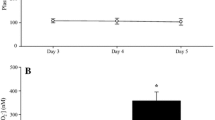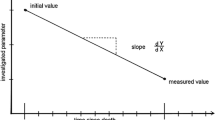Abstract
We measured 45 biochemical indices of blood serum samples in six volunteers aged 23–35 years before and after 3-min exposure to air cryosauna at a temperature of–70°С. We observed an increase in the activity of glutamate dehydrogenase (by a factor of 3.4), aspartate aminotransferase (by 46%), lipase (52%), lactate dehydrogenase (16%), cholinesterase (18%), leucin aminopeptidase (12%), and prostatic acid phosphatase (45%). Moreover, we observed an increase in the level of free fatty acids (by a factor of 2.8), HDLcholesterol (by 10%), creatinine (21%), glucose and ß-hydroxybutirate (11%), high-sensitivity C-reactive protein (12%), potassium (14%), and chlorides (7%). In contrast, atherogenic index values decreased by 14% compared with background level. Most of changes in biochemical blood parameters mentioned above remained almost constant within 20, 60, and 180 min after 3 min of cryosauna; the values did not reach their initial levels. It is concluded that urgent adaptation of human body to low temperatures is associated with increased intensification of reactions in the respiratory chain of mitochondria, an increase in the rate of metabolic reactions due to the elevated production of energy substances resulting from activation of lipolysis and glycolysis.
Similar content being viewed by others
Change history
14 August 2018
Reference no. 5 should read as follows:
References
Pastukhov, Yu.F., Maksimov, A.L., and Khaskin, V.V., Adaptatsiya k kholodu i usloviyam Subarktiki: problemy termofiziologii (Adaptation to the Cold and Subarctic Conditions: Problems of Thermophysiology), Magadan: Sev.-Vost. Nauch. Tsentr, Dal’nevost. Otd., Ross. Akad. Nauk, 2003, vol. 1.
Venditti, P., De Rosa, R., Caldarone, G., and Di Meo, S., Functional and biochemical characteristics of mitochondrial fractions from rat liver in cold-induced oxidative stress, Cell Mol. Life Sci., 2004, vol. 61, no. 24, p. 3104.
Maeda, T., Fukushima, T., Ishibashi, K., and Higuchi, S., Involvement of basal metabolic rate in determination of type of cold tolerance, J. Physiol. Anthropol., 2007, vol. 26, no. 3, p. 415.
Wang, J.-J. and Chen, C.-C., Study of the effect of short-time cold stress on heart rate variability, Proc. 13th Int. Conf. on Biomedical Engineering, New York: Springer-Verlag, 2009, vol. 23, p. 490.
Lutsenko, D.G., Shilo, A.V., Marchenko, L.N., et al., Specific regulation of heart rhythm under different types of cold adaptation in rats, Probl. Kriobiol. Kriomed., 2013, vol. 23, no. 2, p. 105.
Lunt, H.C., Barwood, M.J., Corbett, J., and Tipton, M.J., Crossadaptation: habituation to short repeated cold-water immersions affects the response to acute hypoxia in humans, J. Physiol., 2010, vol. 588, no. 18, p. 3605.
Kamyshnikov, V.S., Spravochnik po klinikobiokhimicheskim issledovaniyam i laboratornoi diagnostike (Guidebook on Clinical Chemistry Tests and Laboratory Diagnosis), Moscow: MEDpress-Inform, 2009.
Tret’yak, L.N., Obrabotka rezul’tatov nablyudenii. Uchebnoe posobie (Experimental Data Processing: Manual), Orenburg: Orenb. Gos. Univ., 2004.
Kulikov, V.Yu., Semenyuk, A.V., and Kolesnikova, L.I., Perekisnoe okislenie lipidov i kholodovyi faktor (Lipid Peroxidation and Cold Factor), Novosibirsk: Nauka, 1988.
Bignucolo, A., Appanna, V.P., Thomas, S.C., et al., Hydrogen peroxide stress provokes a metabolic reprogramming in Pseudomonas fluorescens: enhanced production of pyruvate, J. Biotechnol., 2013, vol. 167, no. 3, p. 309.
Evdokimova, O.V. and Gorodetskaya, I.V., The influence of experimental hypothyroidism and low doses of L-thyroxin on the activity of aminotransferases and gamma-glutamyltransferase in blood affected by different stresses, Vestn. Vitebsk. Gos. Med. Univ., 2013, vol. 12, no. 4, p. 34.
Solov’eva, A.G., Razmakhov, A.M., Luzan, A.S., et al., Mitochondrial lactate dehydrogenase from rats liver after cold stress, Fundam. Issled., 2008, no. 2, p. 56.
Avakyan, A.R., Lazarev, A.I., Prokopenko, L.G., and Uteshev, B.S., Immunomodulative action of the activators of carbohydrate and lipid metabolism in acute cold stress, Eksp. Klin. Farmakol., 2002, vol. 65, no. 3, p. 50.
Kushnerova, N.F., Sprygin, V.G., Fomenko, S.E., et al., The influence of stress on the lipid and carbohydrate metabolism in the liver: prevention, Gig. Sanit., 2005, no. 5, p. 17.
Zhigulina, V.V., Biochemical response of the organism to stress: literature review, Verkhnevolzhsk. Med. Zh., 2014, vol. 12, no. 4, p. 25.
Vel’kov, V.V., Free fatty acids as a new marker of insulin resistance and ischemia, Dal’nevost. Med. Zh., 2008, no. 4, p. 120.
Higgins, C., Understanding Laboratory Investigations for Nurses and Health Professionals, New York: Wiley, 2007.
Lubkowska, A., Szygula, Z., Klimek, A.J., and Torii, M., Do sessions of cryostimulation have influence on white blood cell count, level of IL6 and total oxidative and antioxidative status in healthy men? Eur. J. Appl. Physiol., 2010, vol. 109, p. 67.
Zarubina, I.V., Ganapol’skii, V.P., Aleksandrov, P.V., and Shabanov, P.D., Metoadaptogenic properties of trekrezan in healthy volunteers after cold exposure, Psikhofarmakol. Biol. Narkol., 2007, vol. 7, no. 1, p. 1459.
Hauton, D., May, S., Sabharwal, R., et al., Coldimpaired cardiac performance in rats is only partially overcome by cold acclimation, J. Exp. Biol., 2011, vol. 214, no. 18, p. 3021.
Sayapina, I.Yu. and Tseluiko, I.S., Dynamics of quantitative indicators of Leydig cells in the organism adaptation to low temperatures, Dal’nevost. Med. Zh., 2011, no. 2, p 84.
Postnikova, S.L., Kasatova, T.B., Vereshchagina, G.S., and Malysheva, N.V., Magnesium and cardiovascular diseases, Kardiologiya, 2007, vol. 15, no. 20, p. 1.
Mishchuk, N.E., Hypothermia, Med. Neotlozhnykh Sostoyanii, 2006, no. 4 (5), p. 42.
Postnikov, A.A., Vodno-mineral’nyi obmen (Water-Mineral Metabolism), Moscow: Triada-Farm, 2004.
Prosina, L.A. and Lomteva, N.A., Free radical processes in the tissues of the thyroid and adrenal glands of immature male rats in the early period of cold exposure and their dependence on adaptation to periodic cooling, Estestv. Nauki, 2007, no. 4 (21), p. 73.
Author information
Authors and Affiliations
Corresponding author
Additional information
Original Russian Text © O.A. Juravlyova, A.A. Markin, D.S. Kuzichkin, M.M. Saltuikova, V.I. Loginov, I.V. Zabolotskaya, L.V. Vostrikova, 2018, published in Fiziologiya Cheloveka, 2018, Vol. 44, No. 3, pp. 109–115.
Rights and permissions
About this article
Cite this article
Juravlyova, O.A., Markin, A.A., Kuzichkin, D.S. et al. Features of Human Metabolic Reactions under Extreme Cold Exposure. Hum Physiol 44, 330–335 (2018). https://doi.org/10.1134/S0362119718030167
Received:
Published:
Issue Date:
DOI: https://doi.org/10.1134/S0362119718030167




